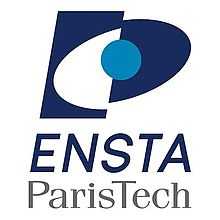ENSTA ParisTech
Coordinates: 48°50′03″N 2°17′00″E / 48.834246°N 2.283331°E
| ENSTA ParisTech | |
|---|---|
| École Nationale Supérieure de Techniques Avancées | |
 | |
| Established | 1741;[1] 1970[2] |
| Type | Public ; under military supervision |
| President | Elisabeth CREPON |
| Academic staff | 180 permanent ; 650 temporary[3] |
| Students | 580[3] |
| Location | Palaiseau, France |
| Website | http://www.ensta.fr |
ENSTA ParisTech, École Nationale Supérieure de Techniques Avancées (English: Superior National School of Advanced Techniques), is one of the most prestigious and selective French grande école in engineering. It is a member of ParisTech (Paris Institute of Technology).
It is located in Palaiseau (48°42′30″N 2°13′20″E / 48.708345°N 2.222099°E), next to École polytechnique.
Every year about 150 engineers graduate from it.
ENSTA offers its students general engineering training with the aim of enabling them to design, produce and oversee complex industrial systems, while meeting strict economic constraints and dealing with an international environment. To do this, the School provides high-level scientific and technological training, which is frequently updated to keep pace with changes in the leading edge technologies and supplemented by language, general culture, law and economics teaching.
The teaching is given by research professors at ENSTA with the participation of numerous auxiliary teachers from the economic and industrial world familiar with the latest technical developments in a wide variety of fields.
Research, which is one of the School's primary missions, makes a dynamic contribution in both the fundamental and applied fields, to the School's pedagogical project and to meeting the needs of business. Half is the responsibility of the School's research professors, and the other half is carried out by researchers from the CNRS, the INSERM and the École polytechnique working in ENSTA's premises.
The general nature of the training given enables ENSTA graduates to find a career in a large number of sectors such as the automotive or naval industry, networks and telecommunications, space propulsion, robotics, oceanology and the environment. Most of the ENSTA graduate engineers are much sought-after by companies and generally find their first job in R&D departments and design offices, rapidly moving towards supervisory and project management posts.
ENSTA is a public teaching and research establishment operating under the supervision of the Ministry of Defence. It is headed by a general officer of the Corps of Ordnance Ingineers (DGA). Some former graduates of École polytechnique attend ENSTA before joining the military Corps of Ordnance Ingineers, which staffs the DGA.
Key figures
- Training
- 135 engineering degrees awarded in 2004
- 9 “Mastère Spécialisé” course degrees in information system architectures
- 8 “Mastère Spécialisé” course degrees in Naval Architecture
- 2 International & Advanced Masters degrees in Maritime Engineering[4]
- Student numbers
- 458 students (excluding doctoral research students)
- 83 foreign students, accounting for 18% of student numbers
- Courses available
- 343 courses
- 31 law, economics, management courses
- 24 culture and communication seminars
- 9 languages taught
- The teachers
- 100 full-time research professors
- More than 650 auxiliary teachers
- International relations
- 41 exchange and partnership agreements with foreign universities
- 7 double-degree agreements
- Research
- About sixty doctoral research students in 2004
- About a hundred publications in reading committee reviews in 2004
History and traditions
Originally, the School was the brainchild of Henri-Louis Duhamel du Monceau, inspector general of the Navy. He had identified the need to give the Navy's master carpenters a theoretical education, particularly in mathematics and physics, which were making quick progress, so that they would have a clearer understanding of their trade.
Duhamel du Monceau founded the first school in his home in Paris on the Isle Saint Louis in 1741. This date is recognised as the origin of the institution. In 1748 it was moved to the royal library on rue Richelieu, and in 1753 to the Louvre Palace, immediately adjacent to the Academie des Sciences. It was closed in 1759 during the Seven Years War. In 1765, he managed to persuade the duc de Choiseul to reopen it as part of a sweeping overhaul of the navy. Duhamel du Monceau continued to run the school for the rest of his life.
The School of Student Engineer Constructors, as it was known, was closed in 1793 during the French Revolution. It reopened in 1795 as an application school for the Ecole Polytechnique. Later on, it became known as "Ecole nationale supérieure du Génie Maritime" (National Higher College of Maritime Engineering).
In 1970, the Délégation Générale pour l'Armement (Arms administration of the Ministry of Defence) merged the school with three of its other establishments:
- the École Nationale Supérieure des Poudres (Powders and explosives institute)
- the École Nationale Supérieure de l'Armement (Arms engineering institute)
- the École des Ingénieurs Hydrographes de la Marine (Hydrographic institute.
This formed the École Nationale Supérieure de Techniques Avancées (ENSTA), the role of which is to train engineers in the naval, mechanical, nuclear, chemical, electronic and related fields. The scientific skills of each of the founding institutes survives in the broad range of research disciplines covered at ENSTA, as well as in the more general nature of its teaching and the variety of specialities offered to the students.
Today, ENSTA's legal status is that of a "public administrative establishment", placed under the supervision of the Ministry of Defence.
Famous alumni
- Louis-Émile Bertin
- Alain Bouquin, General Commander of the French Foreign Legion
- Eugène Deloncle
- Charles Dupin
- Henri Dupuy de Lôme
- Ernest Mercier
- Édouard Jean Baptiste Milhaud
- Jacques-Noël Sané
- Léonce Verny
- Paul Marie Eugène Vieille
References
- ↑ 1741 is the foundation of the École des ingénieurs-constructeurs des vaisseaux royaux, ancestor to the ENSTA.
- ↑ 1970 is the foundation of the ENSTA per se.
- ↑ 3.0 3.1 official website retrieved March 2009.
- ↑ Maritime Engineering & Architecture Programs
External links
| ||||||||||||||||||||
| |||||||||||||||||||||||||||||||||||||||||
| |||||||||||
| ||||||||||||||||||||||||||||||||||||||||||||||||||||||||||||||